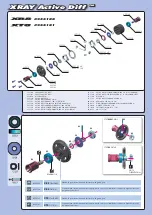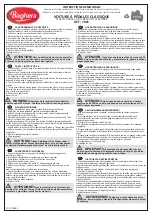
EN
6
FORD
®
RAPTOR BAJA REY
®
: 1:10 4WD RTR • INSTRUCTION MANUAL
CONTROL TEST
Perform a control test with the vehicle wheels off the ground. If the wheels rotate after the
vehicle is powered ON, adjust the Throttle Trim until they stop. To make the wheels move
forward, pull the trigger. To reverse them, wait for the wheels to stop, then push the trigger.
When moving forward, the wheels should maintain a straight line without any steering wheel
input. If not, adjust the Steering Trim, so the wheels maintain a straight line without having to
turn the steering wheel.
DRIVING PRECAUTIONS
• Maintain sight of the vehicle at all times.
• Inspect the vehicle for loose wheel hardware.
• Inspect the steering assembly for any loose hardware. Driving the vehicle off-road
can cause fasteners to loosen over time.
• Do not drive the vehicle in tall grass. Doing so can damage the vehicle or electronics.
• Stop driving the vehicle when you notice a lack of power. Driving the vehicle when
the battery is discharged can cause the receiver to power off. You may lose control
of the vehicle.
• Do not apply the throttle in forward or reverse if the vehicle is stuck. Applying throttle
in this instance can damage the motor or ESC.
• After driving the vehicle, allow the electronics to cool to ambient temperature before
using the next battery pack.
RUN TIME
The condition of a battery pack is also an important factor in both run time and speed.
The battery connectors may become hot during driving. Batteries will lose performance
and capacity over time.
Driving the vehicle from a stop to full speed repeatedly will damage the batteries
and electronics over time. Sudden acceleration will also lead to shorter run times.
TO IMPROVE RUN TIMES
• Keep your vehicle clean and well maintained.
• Allow more airflow to the ESC and motor.
• Change the gearing to a lower ratio. A lower ratio lowers the operating temperature of
the electronics. Use a smaller pinion gear or larger spur gear to lower the gear ratio.
GETTING STARTED
1. Power on the transmitter.
3. Perform a test of the transmitter’s control of the vehicle with the
vehicle’s wheels off the ground.
4. Start driving slowly, and, if the vehicle does not go straight,
adjust the steering trim dial on the transmitter.
2. Power on the ESC.
• ALWAYS
turn on your transmitter before you turn on the receiver in the vehicle.
Always power off the receiver before turning your transmitter off.
• ALWAYS
operate your vehicle in a wide open area. Operating the vehicle in a
small space or indoors can cause overheating at low speeds. Operating at low
speed increases heat in the electronic speed control (ESC). Overheating can
damage the vehicle and failure may result.
OPERATION






































